
Substitute
I have been intrigued by the beer can chicken technique ever since I first saw it done. At first I thought it seemed a little silly and then I realized that perhaps those folks were on to something. Just maybe this would be an awesome idea. However, when I saw it done it typically involved a smoker or using a grill for hours on end.
Those things did not appeal to me. I just sort of stored the concept in the back of my mind. Time had passed and if this were a video blog I would insert some sort of musical montage at this point but since it’s not a video blog, you’ll have to imagine one. Be sure to include jazz hands, headbands, and 80s music.
Trust me it’s fitting because the person who brought the beer can chicken concept back to the forefront of my mind was Guy Fieri. Bling, bling! I saw him make beer can chicken in his oven. “Oh snap, I can totally do that too!” Cue me busting around the house gathering ingredients.
One problem was that I did not have a beer can. Scott and I don’t drink beer out of cans. Call us snobs, but whatever, I’m not doing it. That’s just a road I am not willing to walk down and I also really like beer (as long time readers know) so I stick with bottles. Not to worry, because I am a improvising whiz, I used a 7up can. I also don’t drink pop; however, we have some on hand for company. I dumped the pop and poured in some beer. Beer can chicken was born.
Andrea’s Chili Rubbed Beer Can Chicken
- 1 roasting chicken
- 1 12oz can of beer
- 6oz of beer
- 1C chicken stock (have extra on hand)
For the rub:
- 2tsp of garlic powder
- 1/2 tsp of smoked paprika
- 2 TBSP of good chili powder
- Pinch red pepper flakes
- Grill seasoning (to taste, I used about 1tsp)
- Cayenne pepper (to taste, I used a few sprinkles)
- Salt and pepper (to taste, check salt content of chili powder and grill seasoning before adding too much salt)
Combine all the rub ingredients in a small bowl. Either the day before or early in the morning the day you are going to roast the chicken, rub the chicken with the dry rub you just made. Be sure to get inside the chicken and under the skin. Either place in a casserole dish or plate with high sides and cover wtih plastic wrap. Allow the chicken to sit with the rub in the fridge overnight or for 6-8 hours.
1/2 hour before you plan to start roasting the chicken, pull it out of the fridge and allow to sit on the counter to help bring the temperature of the chicken down closer to room temp. Preheat oven to 375. Fill beer can 1/2 way with beer (6oz of beer). You can also add in garlic cloves and fresh herbs at this point for extra flavor. Place beer can in the roasting pan and fit the chicken on top. You may need an extra pair of hands to hold the can steady for you. In the roasting pan you can add some veggies and chicken stock. About a cup or more of stock to use as a basting liquid. Either drink the other 6oz of beer or you can use that combined with the chicken stock for a basting liquid as well.
Place roasting pan with chicken in the oven and cook until the chicken is done. About an hour and a half. Use a meat thermometer to montior the internal temperature of the chicken. While the chicken is roasting, baste about every 15-20 minutes. This helps keep the outside of the chicken moist and from drying out. Because the chicken is raised on the beer can, the entire chicken is exposed and will roast nicely when monitored.
When the chicken is done, remove from oven and give one last basting. Allow to sit for 10 minutes before removing from beer can and slicing. The beer can will be hot and will also release steam, so take care when removing the can from the chicken. It’s best to gently tip the bird over and remove the can while the chicken is laying flat. You can coat the outside of the can with nonstick spray before cooking for easier removal.
Slice as you normally would and serve!
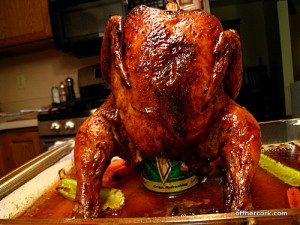
Chili Rubbed Beer Can Chicken
That’s one nice looking bird, isn’t it? I have to say that I was nervous when making this for the first time. I had visions of the chicken exploding or falling over and causing a huge mess. That wasn’t the case at all. It roasted nicely and smelled amazing as it cooked.
I used a red beer, Killian’s, when I made this. You can use whatever beer you have on hand, but I do think a darker beer gives a little bit more flavor to the chicken as opposed to a lighter beer. Feel free to play around with it though and see what what happens.
The reason to have extra stock on hand is because it will evaporate as the chicken roasts. You may need to add more to the pan so your basting liquid doesn’t run out.
Normally I brine my chickens and chicken breasts before cooking them. However, since this was the first time trying out this recipe, I wanted to see how it did without any outside influence. I have to say that this produced one of the juiciest and tenderest non-brined roast chickens I’ve ever had. I was pretty impressed with the taste. Not only was it tender, but the rub, with the help of the beer steam, permeated through the entire chicken. I would make this chicken again in a heartbeat and maybe tweak the rub a little bit as well.
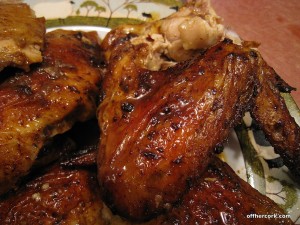
Ready to serve
The thing I loved most about this chicken was the color. The smoked paprika and chili powder present a nice deep color to the chicken, so as it roasts it takes on a nice deep golden color. As I mentioned before, since the entire chicken is exposed due to sitting on the can, the whole chicken turns crispy golden which is very impressive to look at and would make a great presentation for serving guests.
Enjoy guys! And remember, always play with your food!
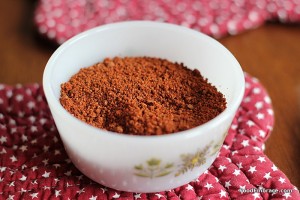 You all know that I love a good rub down. Personally I’ll take a well rubbed hunk of animal over a marinated one any day of the week.
You all know that I love a good rub down. Personally I’ll take a well rubbed hunk of animal over a marinated one any day of the week.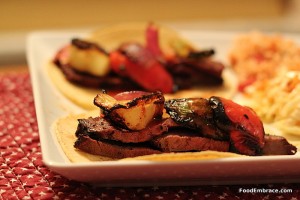 I’ve used this rub on a rack of ribs and also on some flank steak. I prefer it on the steak! It gave the steak an very lovely deep color as it grilled, along with providing a nice crust on the outside.
I’ve used this rub on a rack of ribs and also on some flank steak. I prefer it on the steak! It gave the steak an very lovely deep color as it grilled, along with providing a nice crust on the outside.
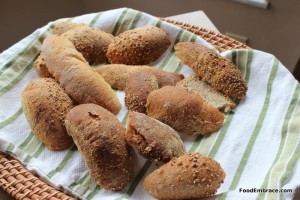
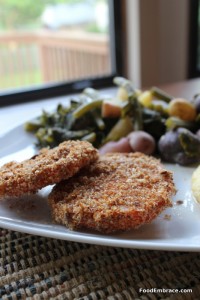
 The first time I’ve ever had bread and oil as part of a meal was back in North Carolina, about 7 years ago. Scott and I had just purchased our first house and we were out having a celebratory lunch. The server brought out a basket of warm bread and a little dish that she poured seasoned olive oil into, then quickly scurried away.
The first time I’ve ever had bread and oil as part of a meal was back in North Carolina, about 7 years ago. Scott and I had just purchased our first house and we were out having a celebratory lunch. The server brought out a basket of warm bread and a little dish that she poured seasoned olive oil into, then quickly scurried away.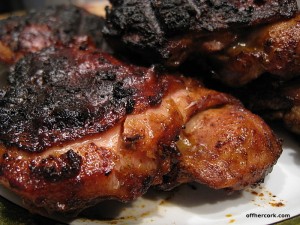
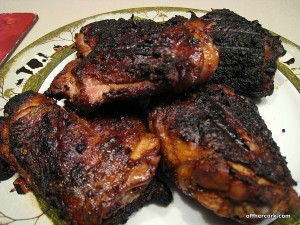
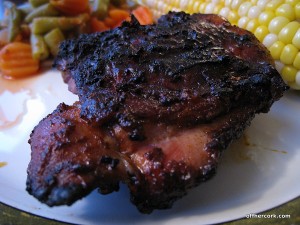



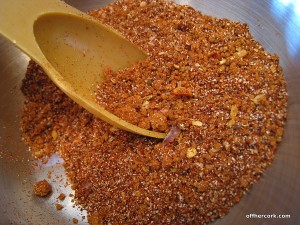
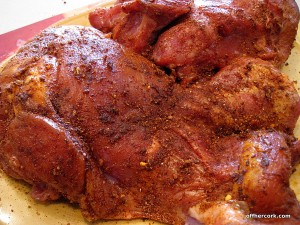
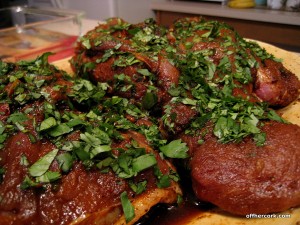
 These were turkey thighs, and you can see how much juice and goodness happened just after sitting the day away with the rub.
These were turkey thighs, and you can see how much juice and goodness happened just after sitting the day away with the rub.